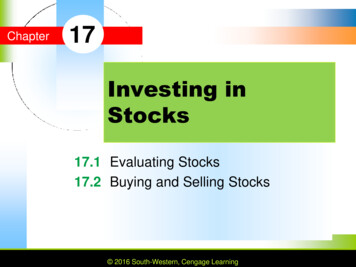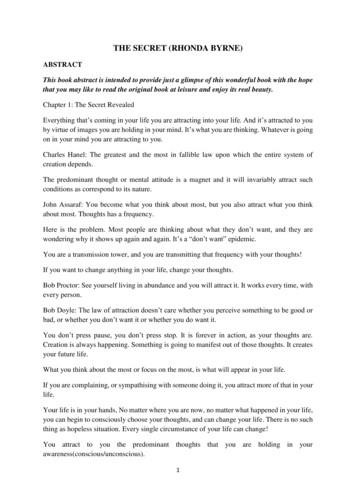
Transcription
ALGAINSBYLARRY WILLIAMSWINDSOR BOOKS, Brightwaters, New York
TABLE OF CONTENTSPageCHAPTER ONEMY MILLION DOLLAR STOCK MARKET CONCEPTSELECTING STOCKS TO OUT PERFORM THE MARKETWHY THE WORD FORECASTING IS IMPORTANT113WHAT I LEARNED ABOUT CHARTSWHAT I LEARNED ABOUT MOVING AVERAGESTHREE NEW WAYS TO USE MOVING AVERAGESWHAT I LEARNED ABOUT FUNDAMENTALSHOW TO TELL IF A STOCK IS FUNDAMENTALLY SOUNDCHECK THE YIELDHOW TO DETERMINE A COMPANY'S GROWTH RATEHOW I DISCOVERED THE MILLION DOLLAR CONCEPTA 13 POINT GAIN JUST LAST WEEK357899101011CHAPTER TWOMY FIRST TOOL FOR SELECTING THE BEST STOCKSTHE TWO METODS I USE TO IDENTIFY ACCUMULATION& DISTRIBUTIONDISCOVERING THE PROFESSIONALSCOMPARATIVE STRENGTH, THE SECRET TO FOLLOWING ALLSTOCKSTHERE'S A PATTERN TO EVERYTHING - ESPECIALLYACCUMULATIONHOW TO USE STOCK CHARTSTHE ACCUMULATION PATTERN151515SOME POINTERSTHE DISTRIBUTION PATTERNHOW TO BEST USE THE PATTERNSADDITIONAL POINTERS17182021CHAPTER THREEMY SECOND TOOL FOR SELECTING STOCKSHOW YOU CAN TRACK THE DAILY SUPPLY/DEMAND BATTLETRACKING THE DAILY SUPPLY/DEMAND BATTLE IS ALLIMPORTANT12121314.LET'S SHATTER SOME PRECONCEIVED NOTIONSWHY WE DO NOT USE YESTERDAY'S CLOSE IN OUR OBSERVATIONNOW WE KNOW WHO WON THE BATTLE, BUT BY HOW MUCH?.ENTER VOLUMEHOW TO TELL WHEN THE PROFESSIONALS ARE IN CONTROLOF A STOCK,MORE EXAMPLES FOR YOUR BENEFIT .222424252626262728
PageCHAPTER FOURHOW TO PROFIT FROM THE ACCUMULATION DISTRIBUTIONFORMULAHERE IT IS. THE MILLION DOLLAR FORMULAWHY DO WE USE VOLUME?HOW TO CONSTRUCT A FLOW LINE OF PROFESSIONAL ACTIVITY .30303131SOME TIME SAVING TIPSHOW TO SPOT THE BASIC BUY SIGNALWHAT THIS MEANSWHAT THE BASIC BUY SIGNAL LOOKS LIKEHOW TO IDENTIFY THE STRONGEST POSSIBLE BUY SIGNALS.HOW TO SPOT THE BASIC SELL SIGNALWHAT THE SELL SIGNAL MEANSHOW TO IDENTIFY THE STRONGEST POSSIBLE SELL SIGNALS . . .THE IMMEDIATE PROFIT SIGNAL'.THE CHINESE33343435353637373839CHAPTER FIVESHOULD YOU FOLLOW THE SHORT OR INTERMEDIATE TERMTRENDS AND HOW TO DO ITHOW TO FORECAST SHORT TERM MOVESMY FAVORITE SHORT TERM INDICESHOW TO TELL WHEN THE MARKET HAS REACHED A SHORTTERM OVERBOUGHT/SOLD POINTWHEN TO TAKE ACTIONAN EXPLANATION OF THE MOMENTUM INDEXHOW TO FORECAST INTERMEDIATE TERM MOVESMY FAVORITE INTERMEDIATE TERM INDICESWHERE WILL THE MARKET GO?-"WILL GO" KNOWS!YIN AND YANG, REVISITEDA FINAL INTERMEDIATE TERM INDEXCHAPTER SIXHOW CYCLES CAN IMPROVE YOUR STOCK TIMINGTHE SECRET OF IDENTIFYING INDIVIDUAL STOCK ING THE PATTERNSMEASURING THE CYCLE'S MOMENTUM5758PRECISION TIMING WITH CYCLESPOLITICS AND THE MARKET6061
CHAPTER SEVENWHAT YOU NEED TO KNOW ABOUT LONG TERM STOCKMARKET TIMINGHOW TO IDENTIFY A SELLING CLIMAXWHAT A MAJOR TOP LOOKS LIKETWO FUNDAMENTAL INDICATORS TO SPOT MARKET TOPSPage.62626466HOW MONEY SUPPLY CAN HELP YOUTHREE TECHNICAL INDICATORS TO SPOT MAJOR TOPSHOW TO CALL A MAJOR STOCK MARKET BOTTOMFOUR INDICATORS TO CALL A MAJOR BOTTOM67687272THE STOCK MARKET'S MASTER CYCLICAL PATTERNTHE MASTER PATTERN IDENTIFIED7575PHASE ONEPHASE TWOPHASE THREEA LOOK AT THE RECORDA 35 YEAR STOCK MARKET PROJECTIONPOINTS TO REMEMBER767677777980CHAPTER EIGHTHOW TO COMBINE MARKET TIMING AND STOCK SELECTION . .81DOCTORS HAVE STETHESCOPESTHE SECRET TO TIMING PROFITSA WORD ABOUT YOUR EMOTIONSHOW TO TELL WHEN THE TIME IS RIGHTALL THAT'S LEFT TO DOHOW TO AVOID BUYING TOO HIGH OR LOWMY PERSONAL CHECK-LISTMASTER CHECK-LIST FOR MAKING STOCK MARKET TRADESHOW TO DEVELOP PATIENCE-OR-MY LOSS IS YOUR GAINHOW TO AVOID WAITING TOO LONGTHE TWO THINGS I WAIT FOR8181828284848485858687.CHAPTER NINEHOW TO KNOW WHEN IT'S TIME TO SELLTHIS SCREAMS SELL8888WHAT'S THE BEST DAY FOR SELLING? . 'HOW TO AVOID SELLING TOO LATE OR TOO EARLY .8990
CHAPTER TENPageHOW TO BEGIN USING MY METHODSSTART BY DOING THIS9292WHERE TO GET THE INFORMATION YOU NEEDWHO WILL HELP YOU?9495HOW TO USE BROKERS TO YOUR ADVANTAGEHOW TO PAY LESS IN BROKERAGE COMMISSIONSWHAT STOCKS TO FOLLOWHOW TO SPOT LONG TERM GROWTH STOCKS FROMTHE CHARTS95969798A SPECIAL SECRET ABOUT SELECTING STOCKS TO FOLLOW . . . .WHEN TO MAKE YOUR FIRST TRADE9999THE FIVE MOST COMMON CAUSES OF STOCK MARKET LOSSES. .100CHAPTER ELEVENHOW TO START MAKING MONEY IN THE MARKET. .TOMORROW MORNINGSTOCKS TO FOLLOW.'KNOW WHAT THE PROS ARE DOINGHOW TO RATE YOUR TRADESWHAT TO DO WITH YOUR PROFITSMY FINAL COMMENTS102102103104105106CHAPTER TWELVEPRICELESS TRADING HINTSHOW TO GET THE BEST EXECUTIONSWHEN TO BUY AT THE OPENINGWHEN TO USE MARKET ORDERSWHEN NOT TO BUY ON THE OPENINGHOW TO USE STOPS AND WHERE TO PLACE THEM107107107108108110A WORD ABOUT MENTAL STOPSHOW TO FORECAST DAY TO DAY ACTIONHOW TO CAPITALIZE ON THE THREE HOUR CYCLE111111112
PREFACEWriting an author's update for a book that was written 15 years ago is a real challenge!The real challenge is that I am tempted to change some of what appeared in the original copy of thisbook. But in reading and rereading the book I see that the book simply does not need to be reauthored orrechanged.The tools, techniques, indicators and strategies discussed in the book are as valid now as they were in1969 when the book was written.There are two things that I would like to stress upon people reading The Secrets of Selecting Stocks, forthe first time.First, is that these indicators have stood the test of time.I have received letters and phone calls from people who literally swear by the accumulation/distributiontechnique discussed in this book. Perhaps the greatest thrill of writing this book came in the form of apostcard sent to me from a lawyer who was on vacation in the South Pacific. The postcard simply said,"Larry, my wife and I are taking this vacation because of the profits we made following the indicatorsand especially your accumulation/distribution technique as you presented it in your book. We both areenjoying the sunshine and thank you very much."Much of the technical work you see being done today by leading advisors is a spinoff of what appearedin this book, so for no other reason than historical purposes I do not want to change what was originallywritten about in the book. This book seems to have been a Genesis for a great deal of thinking abouttechnical approaches to the market.The indicators still work and they still work in the same fashion. As they say, if it is not broken why fixit?Perhaps the longest term value to come from the book is the major forecast made in the book under the39 year pattern that I believe I have been able to isolate that has called some of the very important majorturns.Notice that in the 15 years since the book was written there have been many doomsday calls foreconomic disasters, stock market crashes, and all sorts of arguments from the purveyors of pessimismabout how bad the world is going to get. In fact, what has taken place has pretty much been in line withthe forecast made in this book.A study of this major forecast will give you an economic road map of where the economy and stockmarket is headed for a long time to come.Yes, there will be a major crash in the stock market. The big question is not that it will occur, but whenit will occur. The answer to that is in this book.My own trading style appears to have smoothed pretty much in gear with what I see most traders doing.We cut our teeth trading stock and then moved into commodities. Most of my own trading experience isnow in commodities because commodities are more easily traded, especially due to the low discount ratein stocks. Interestingly enough however, the tools that I use to trade commodities with are very similar ifnot the exact same tools discussed in this book.The markets have been my life. It has been a good one, I hope it is for you as well.Cordially,Larry Williams
CHAPTER ONEMY MILLION DOLLAR STOCK MARKET CONCEPT
MY MILLION DOLLAR STOCK MARKET CONCEPTA cold wind was blowing through Wall Street in the Fall of 1971. After adramatic 100 point rally ignited by President Nixon's announcement of Wage &Price Controls, the market suddenly reversed itself and began to plummet. Thingslooked bad. The DJIA had just broken its support point and fallen to a new low.Many analysts announced that we had begun a Bear market.I didn't think so. That was because a few of the select indicators I keep weregiving bullish readings for the stock market. Reflecting back upon it, I'm certain Iwas as influenced emotionally by the break to new lows as anyone. Things lookeddismal. I felt a knot in the pit of my stomach. But when I turned to look at myindicators, the ones I will be discussing in just a few more chapters, I noticed theywere in a distinct bullish area. Their message was clear: they were telling us to buystocks. So I did.SELECTING STOCKS TO OUT PERFORM THE MARKETWithin just a very few days, the market began one of the strongest advances it hadmade for many years. Shortly before the market began its tremendous 22%up-move from the 800 area to the 960 area, I bought four stocks for my ownaccount.The four stocks I purchased showed a net increase of over 52% in value during thenext six months, whereas the popular averages increased only 22%. Had onepurchased and held the same amount of these four stocks as I purchased at theNovember low point, he would have had a profit of slightly over 308,000.00some 5 1/2 months later.I am giving you these facts to show why I believe my stock selection is of valueand to substantiate some of the things I am going to be discussing with you.With a little bit of luck in calling important market turning points, one should beable to buy stocks that show about the same percentage moves as the DJIA.However, when you consider the four stocks I selected for my own portfolioshowed a gain almost three times greater than the Dow, it does appear there ispredictive value to the system.1
I could go beyond what happened in my own personal account. You see, at thattime I was also writing a stock market letter and, of course, made specificrecommendations with our buy signals sent out during the first part of November,and again, just a few days before the low point was reached.The stocks we were recommending at that time were Federal National Mortgageat 75 and AMF at 38. Levitz we recommended in the 80 area, North AmericanMortgage at 35, MacDonald's at 61, Pickwick at 37, Syntex at 66, Burroughs at131, and IBM at 292. On the 16th of November, we also advised purchasingLennar Corp at 45, Ponderosa Systems at 57, American Research & Developmentat 44, Walt Disney at 104, and Polaroid at 90. As you can tell from the number ofrecommendations we made at this time we were indeed quite bullish on themarket.Exactly five months later, this uniquely selected portfolio showed a sizeable gain.Ponderosa Systems, which had split two for one, was selling on an adjusted basisat 118, up 61 points. Syntex was selling for 115, up 49 points, AmericanResearch & Development was selling for 70, up 26 points, Disney for 165 up 61points, Polaroid for 132, up 42 points. Federal National Mortgage, which had runup as high as 108 on an adjusted basis for a stock split, was selling at 97, up 21points on the adjusted basis. AMF was selling at 66, up 28 points. Levitz, whichhad run up as high as 162, was selling at 135, up 55 points. North AmericanMortgage was selling for 34, down 1 point, MacDonalds at 102, up 41 points,Pickwick for 48, up 11 points, Burroughs for 175, up 44 points; InternationalBusiness Machines for 395, up an incredible 103 points. The only stock to show asizable loss was Lennar Corp. which was then selling at 36 down 9 points. Theinitial portfolio value was 115.5 per share. Five and a half months later the valuewas 168.8. The portfolio had increased 46.1%. Keep in mind that this was duringa period of time when the market itself, as measured by any of the popularaverages, was up about 20%. Our specially selected stocks performed twice as wellas the averages.I believe this is conclusive evidence that my stock selection system, the one youare about to learn, does have the unique ability to select stocks that are going toout-perform the market on both the long and short sides. What happened in myaccount, the 308,000.00 profit I mentioned earlier, was not a random event dueto luck or my good looks. It was due to my stock selection system that has beenproven time and time again to have significant forecasting value.
Making money in the stock market is far from simple. Don't let the above fewparagraphs lull you into feeling Wall Street is an easy path to instant riches. Itisn't. . . just like anything of value, it takes hard concerted work to be successful.But let me also point out that I have been able to consistently make moneytrading stocks in my own account as well as in public recommendations in theadvisory service I used to publish, "Williams Reports."WHY THE WORD FORECASTING IS IMPORTANT - My abilities to usually callmarket turns and individual stocks is the direct result of a good deal of study andresearch into the marketplace. In the beginning, I tried to latch on to otherpeoples' supposedly successful methods.When it comes to making money in the market, I'm not proud . . . I'll try anyhalfway logical method or system to generate profitable trades. That means I'veread all the books on fundamentals, methods and technical systems. In fact, Ieven dabbled a bit in some interesting research on stock market and astrologicalrelationships.It wasn't long before I learned that if a system is to be profitable it must forecastwhat will happen in the future.That little sentence is the real key to understanding the stock market. If an indexor approach is to work, it is because it has forecasting ability. In examiningvarious market theories, my first thought is to study the basics of the system tosee if the raw data has forecasting significance. If not, the method cannot work!Along the road to the discovery of my key to the stock market, I tried andstudied many, many different approaches. I'd like to share a few of my views onthe more common systems for stock market trading and investing in an effort tohelp you separate the wheat from the chaff.WHAT I LEARNED ABOUT CHARTSAt some point in his life, every market participant, be he trader or investor, takesa look at charts and reads a few books on how to chart your way to wealth. Ifound the only people charting their way to wealth were the authors of thebooks! Try for the life of me, I could not find a workable charting program,formation, or whatever other mysterious forecasting element was supposed toexist on the charts.3
In today's mail I received a flyer from one of the widely followed chart services.Their central advertising claim is that charts could help traders and investorsbecause, as they said, "Charts are a natural for stock trading, since they give thefull results of all supply/demand factors. They reflect insider buying and selling,"smart money" accumulation and distribution, important news before it ispublished — in fact, everything that anybody knows or does."This is the general view of those entrenched in the chartists' camp. They feelcharts, through various formations and configurations, reflect the true supply/demand picture and thus have forecasting value. There are many books oncharting and almost as many chart formations or patterns as there are stocks. But,by and large, most chartists look for a few basic chart patterns.Chart 1Chart one shows several of the more basic chart formations such as the head andshoulders, boxes, diamonds and a pennant. You will find these patterns illustratedin any of the books on stock market charting.Keep in mind that charting is based on the assumption that a chart correctlydepicts the supply/demand battle. As such, charts enable one to spot developments that depict a bullish or bearish supply/demand pattern. Supposedly, thesepatterns repeat and forecast future market or stock action. It's certainly a niceconcept.4
But two things bother me about the frayed-cuff chartists . . First of all, I do notknow of any chartists who are really very wealthy or doing exceptionally well inthe market. To quote economist Paul Samuelson, "They all have holes in theirshoes." Seriously, of the thousands of people I know in the market, I cannotshow you one chartist who is making money!More importantly, when I notice charts of other activity, such as rainfall in NewYork City, traffic deaths in Los Angeles, or the reproduction rate of CanadianLynx, those same darned supply/demand patterns show up on the charts!This is incredible . . . when charting series of numbers that have no relationship tosupply/demand (certainly we cannot argue there is a supply/demand relationshipto the number of deaths in L.A. County) the same head and shoulders, wings,wedges and upper case Outer Mongolian breakouts occur.The continual re-occurence of the same "supply/demand" patterns in non-supply/demand phenomena must splash a good deal of cold water on any forecastingvalidity the chartists might try to conjure.I suppose the validity of charts will be discussed for many years to come. Therewill even be some lucky chartist who attributes his luck to charts and writes abook or market letter about his charting system. But, as long as the same patternsappear in rainfall statistics and traffic death records, I'm going to have to remain anon-believer. You are urged to do likewise.WHAT I LEARNED ABOUT MOVING AVERAGESOne of my attempts to make a killing in the market centered around the use ofmoving averages. Several authors and market letter writers had turned me on tothe standard use of moving averages. I thought I'd give their methods a try.A moving average is simply an average of a series of numbers. The only differenceis that the average changes each day as we add the new day's information andsubtract the data or information for the number of days ago for which we arerunning the average. Thus, in a 20 day average we add up all values for the last 20days and divide by 20. To make this a "moving average" we wait until tomorrow'sclose, add that figure to our sum and subtract the figure from 21 days ago anddivide by twenty.As with any mathematical average, the resulting values represent a smoothing ofthe raw data. Take a look at the chart shown here and you can get a better feeland understanding for moving averages than I can tell you in thousands of words.5
Chart 2One thing you'll quickly notice is that a moving average acts as a trend line orband of resistance and support to the raw data. Also, when the raw data risesabove the moving average, it continues moving up. When the raw data falls belowthe moving average, the up trend has been reversed and the raw data movessharply lower.The usual moving average methods are based on penetrations of the movingaverage. Thus, if a stock's price rises above its 10 week moving average, a buysignal is given and when it falls below a 10 week moving average, a sell signal isproduced. On paper, and with some stocks, the method appears absolutelyphenomenal.Funny thing though, try as I might I couldn't make any money using the movingaverage system. I was perplexed. I re-read the rules, but again, I lost money.Finally a bolt of lightening hit me . the moving average method worked greatwhen it worked . . but when it didn't work, Oh Brother!6
What's more, promoters of the moving average methods selected stocks for whichtheir system worked best in the past. They did not bother to show stocks themethod did not work on. Nor did they bother to carry their system into thefuture. What they did do was find a stock or two that had a big up move and a bigdown move. Their moving averages were placed on this trend and captured a largepart of both moves. Stocks that did not have large moves but traded in narrowconfines were not shown because these situations produced losses!Most of the moving average systems are based upon a 10 week average. The bigquestion is, as always, will the moving average system work and if so to whatdegree?Recently articles have appeared in the Financial Analyst's Journal discussingvarious longer term moving averages. One study randomly selected 30 NYSEissues between 1960 and 1966 and tested 100,150, and 200 day moving averages.Signals were generated by either an absolute penetration of the moving average ora percentage greater than the moving average — a filter — above and below theaverage itself.Using the 100 day average with no filter produced a 57% loss of capital. Using a200 day moving average produced a drop of 34% in starting capital. Whether oneused a 100, 150 or 200 day moving average with no filter, or a 2%, 5%, 10% or15% filter, he would have lost money during this 6 year period!In June 1969, in an effort to devise a profitable trading method, I ran a test of 10stocks for 450 market days using shorter term moving averages of 3, 4, 5, 7 and10 day durations with filters of -3%, -1%, 1% and 3%.With the benefit of hindsight and the use of what was at that time the world'slargest computer, I was still not able to devise a profitable trading strategy basedupon the moving average method!THREE NEW WAYS TO USE MOVING AVERAGES - If moving averagesystems are of little value, as the above statistical research demonstrates, is therestill some way they can be used? I think so.To my way of thinking, there are three good ways to use moving averages. Thefirst method is to simply observe the trend of the moving average and as long asthe trend of the moving average is up, assume the stock will go higher. When thetrend of the moving average is down, assume the stock will go lower. In otherwords, trade the long side of a stock only when the moving average is up andtrade the short side only when the trend of the moving average is down.7
Another way to use the moving average draws upon the penetration of movingaverage by price itself. At first glance this seems contradictory because I've justshown that such penetrations do not produce very reliable signals.What I'm suggesting is that you act upon signals from moving average penetrationsif, and only if, other technical or fundamental criteria have been met. In otherwords, once you are certain a stock is bullish or bearish because of another factor,you can then act on signals from the moving averages. In short, you need to weedout the bad moving average signals. This is done by developing a set of criteriathat must first be met before you will act upon any moving average signal. In fact,the moving average signal is the final indication to take action as it simplyannounces that the trend has been reversed.A third way to use a moving average involves using it to measure a stock'smomentum or cyclical harmonics. This is a more involved topic and will bediscussed in detail later on.WHAT I LEARNED ABOUT FUNDAMENTALSIt stands to reason that if a company's fundamental position is one of greatbullishness, the stock price will stage a handsome advance. The only problem hereis identifying what fundamentals are bullish, or bearish, for that particularcompany, industry and market situation at the time. Or, so it seems.Some of the most powerful fundamental situations have never advanced ordeclined while some of the most fundamentally bearish stocks doubled andtrippled in value!Several years ago, there was a hot little number on Wall Street called FourSeasons. Fundamentally the stock was a short sale and many knew it. But thefundamentals did not prevent the stock zooming, from 20 to over 100! About twoyears after the big run up, the fundamentals caught up with the company andthey filed for bankruptcy. But in the meantime, the fundamentalists that shortedthe stock in the 20, 30, 50, 60 and 70 area were clobbered and they too"filed" for bankruptcy.General Motors is another good case to study. The long term outlook for GMcan't be too bad. Yet GM made its all time high in 1965 and has neverparticipated in any substantial up move since then. Time and time again you'll seemany fundamentally bullish stocks take nosedives while the fundamentallybearish stocks fly to the moon!8
HOW TO TELL IF A STOCK IS FUNDAMENTALLY SOUND - In all of myresearch I have found only two reliable measures of fundamental value. Oneconcerns itself with yields, the other with the company s growth rate.CHECK THE Y I E L D — The first and most important fundamental statistic is thestock's yield. Generally speaking, a low yield is bearish for a stock and a highyield is bullish. But just what is a low yield for any given stock? This is bestobtained by checking the stock's historical 10-20 year record. Almost withoutexception, you'll quickly see that all major tops in the stock come at a time oflow yields and usually this low yield will be about the same at all tops.By the same token, all the stock's important lows will usually be found whenthe stock is at a high yield and always about the same general level. Thus we canestavlish overvalued and undervalued levels of yield for each stock based uponthat stock's historical record.Chart 3 shows one such example. Notice how all the tops come at low yields ofjust about the same valuation.And the bottoms? It's just the reverse, all the bottoms come at a time of highyields and all the bottoms are marked by the same general level of undervaluationand high yield.Short sale selections should come from stocks showing very low historical yields.Long candidates come from the high yielding stocks.Remember, the higher low yield for one stock, say IBM, will not be the high orlow yield for another stock, say G.M. It's all relative to each stock's individualhistorical record.9
HOW TO D E T E R M I N E A COMPANY'S GROWTH RATE - There are a goodmany ways to look at a company's fundamental growth. The most typical are theP/E ratios. Another method seeks to establish the company's growth rate whileothers look at net sales. All are, to some degree, helpful but usually do not give usadequate figures to compare one stock with another.The payout time formula solves this.This simple formula is nothing more than the number of years it will take earningsper share, compounded at the firm's current growth rate, to reach the price of thestock. Let's say the earning per share is 1.50, the growth rate is 20% per year,and the current price is 30.00. It will take about 16 years for the compoundedearnings to equal the stock's current market value.Lets's take another stock with earnings per share of 1.00, a growth rate of 15%and current market price of 3 a share. In terms of the annualized growth, thisdoes not appear to be as good a buy. But its payout is only some 9 years! Itrepresents a better buy. The lower this payout figure is, the better a fundamentalbuy you have located.HOW I DISCOVERED THE MILLION DOLLAR CONCEPTAs you can tell, I've spent a good deal of money and effort on research trying tocrack the market's mystique. One thing that always fluttered around the back ofmy mind while I looked at charts, moving averages, point and figure charts, andfundamentals was this: all these things do not, in and of themselves, make pricesmove up or down.No matter how bullish the technical structure of a stock is or how impressive itsrate of growth and yield figure, these things do not and cannot be guaranteed toinfluence prices!Then it hit me . the only thing that can possibly make a stock go higher is animbalance of buyers and sellers. It is as simple as that. When there are morebuyers than sellers, prices will advance. Conversely, when there are more sellersthan buyers, prices will go down . . . regardless of the fundamentals!10
As simple as the concept sounds it took several years of research to arrive at ameaningful way to break down the relationships of buyers and sellers as well asmethods to identify the difference between professional and amateur buying.Realizing it was the imbalance of buyers and sellers that influenced prices, I beganstudying the various groups of people in the market, such as the odd letters,specialists, floor traders, etc.Through this process, I discovered a reliable method that breaks down each day'sbuying and selling activity in any stock into the approximate number of sharesbought and sold that day. This method, actually a precise formula, tells me at theend of each day about how many shares were on the buy side and how manyshares were on the sell side. From these figures, I can begin analyzing thesupply/demand battle.I also discovered there is one certain chart pattern that indicates if a stock isunder professional accmulation or distribution. This is a very simple pattern andhas nothing to do with traditionally known chart formations. The comparativepattern graphically tells us what stocks have been under heavy buying and are instrong hands as well as the stocks that have been undergoing professional sellingand are in weak hands.A 13 POINT GAIN JUST LAST W E E K - Let me first tell you that my two phasemethod for analyzing accumulation and distribution is not infallible. It has madefew errors, but, by and large, the method has worked wonders for me.Just last week McDonalds Corp, the hamburger people, appeared to be underheavy accumulation in my work despite a sharp market break. My figures said thestock was ready for an upmove. I put in my order for 1,000 shares at 49%. Allmeasures of accumulation were impressively bullish despite the soft market. Thisstock had been priced for an upmove.As I write this, 7 market days later, MCD is selling at 62, up over 13 points frommy buying indications which came at the 49-50 range. My million dollar, two partconcept, is based upon the central tenent that stock prices advance if, and only if,there are more buyers than sellers and decline if and only if there are more sellersthan buyers.We analyze the buying/selling syndrome in two statistically valid ways to detectprofessional accumulation and distribution. The exact formulas and patterns willbe given to you in a moment,
the secret of identifying individual stock trading patterns 56 identifying the patterns 57 measuring the cycle's momentum 58 precision timing with cycles 60 politics and the market 61 \ chapter seven page what you need to know about long term s











